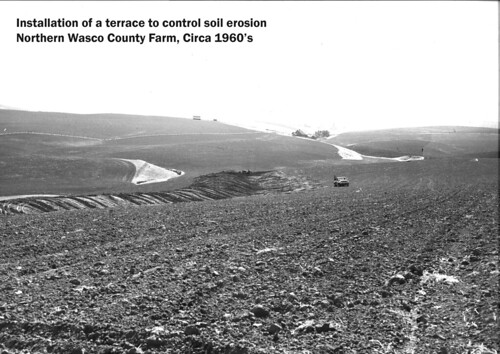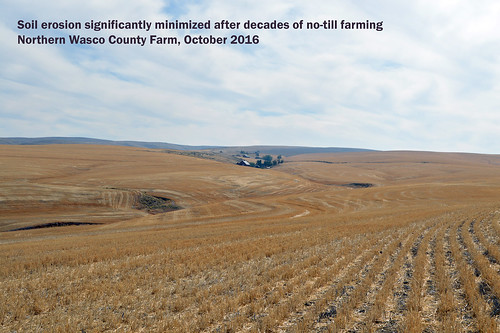By Garrett Duyck

This month, we’re highlighting 12 important gifts given to us when we conserve natural resources: soil, food, plants, wildlife, people, health, protection, recreation, air, water, technology and the future. NRCS’ mission is to conserve the full range of natural resources, but soil health is our foundation. And it’s the first conservation gift that we’re going to highlight. And without soil, we couldn’t celebrate with food. We encourage you to give the gift of conservation this season!
Curbing Soil Erosion
Soil is the foundation for a healthy environment. If you need proof that no-till farming works, look no further than the rolling hills of north-central Oregon.
For decades, this region was dominated by winter wheat farms that used extensive tillage to control weeds during fallow years. It was the conventional way of farming in the area, from the early 1900’s through the 1980’s.
But over time, soil erosion became a serious threat.
Many people living in the region recall stories of roads, houses, and other buildings being buried in silt mud after major rain events. Evidence of severe soil erosion can still be witnessed today in the large gullies that were once roadside ditches.
Enter the Soil Conservation Service (SCS)—now named the Natural Resources Conservation Service (NRCS). Our agency was formed to prevent another Dust Bowl. Beginning in 1935, the agency helped countless farmers in the region install structures like diversions, sediment basins and grassed waterways that would reduce soil erosion and prevent sediment from leaving crop fields. Conservation practices including terraces and no-till farming—a conservation practice that grows crops without disturbing the soil—dramatically reduce soil erosion.
In fact, many farmers have said that if they had to return to conventional tillage, they would rather stop farming because it’s so taxing on themselves and the land.
Increasing Healthy Soils
Healthy soil is the foundation for healthy food. Jay Galusha and the five generations of the Galusha family who have farmed this rugged land, understand no-till and soil health are good for the land and people.
Galusha farms 400 acres of hay land and 220 acres of corn on his Fairfield Dairy Farm in Williamstown, Massachusetts.
“I’ve got quite a bit of hilly ground, so spreading manure’s a challenge. Corn planting is a challenge,” said Jay Galusha. “I’ve got some steep ground. That’s where no-till fits right in.”
In no-till agriculture, the farmer uses a no-till planter to create a narrow furrow just large enough for seed to be placed. By not plowing or disking, cover crop residue remains on the surface, protecting the soil from crusting, erosion, high summer temperatures and moisture loss. Additionally, the soil structure remains intact and improves every year.
No-till farming increases the amount of water that infiltrates into the soil, organic matter retention and cycling of nutrients. It can reduce or eliminate soil erosion. Done in conjunction with cover crops, it increases the amount and variety of microbial life in the soil, which makes soils more resilient and full of nutrients.
Galusha plants rye and hay as cover crops. The sugars exuded by the hay and rye feed microbes in the soil and helps with soil aggregation, which results when soil particles bind to each other more strongly than to adjacent particles. The spaces between the aggregates provide pore space for retention and exchange of air and water. No-till planting into a cover crop encourages earthworms, which feed on the residue and help with the aggregation process. They also create pores and add nutrients.
Earthworms pull the plant residue down into its hole where it attracts bacteria and fungi, which it eats, along with the residue. Then the channel is lined with slime from the worm’s body and is higher in nitrogen, phosphorous, potassium and calcium than the surrounding soil.
“It’s thousands of dollars of savings and it works. It’s so easy. It’s just easy,” said Galusha.
And conservation is beneficial on any scale. NRCS continues to help farmers and ranchers bolster the health, productivity and vigor of their soils. Nationwide, NRCS offers science-based guidance, resources and financial assistance programs to help farmers install soil conservation practices on private lands. To find out what opportunities are available in your area, contact a local USDA Service Center near you.

Source:usda.gov